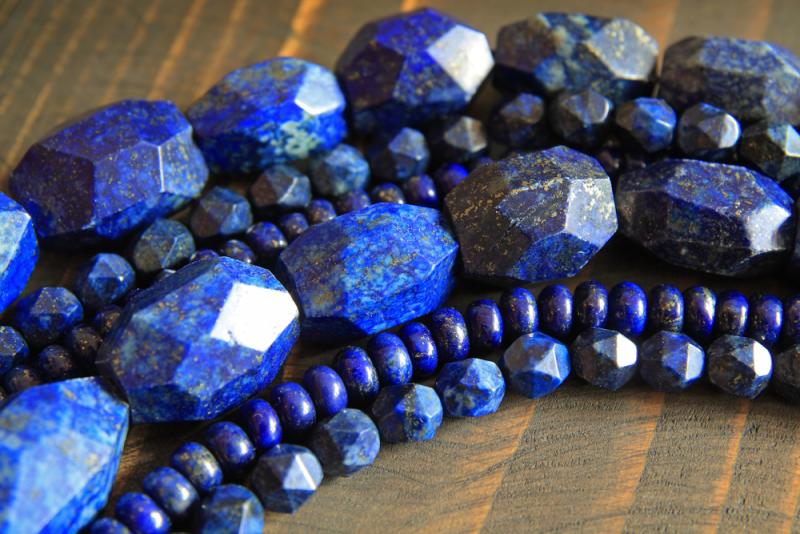LAPIS LAZULI MOUNTAINS AND ITS IMPORTANCE IN ARCHAEOLOGY
Lapis lazuli, known as the rock stone, was used commonly to depict the eyes of miniature works as blue in the ancient times. “Lapis” means “rock” in Latin and “lazuli” comes from “lazulum” word in the same language and this comes from Arabic “lacivert” to Latin.
The blue mountains in Afghanistan has been the mineral spring until 5000 BC and today they still are. The etymological roots of the word stem from Persian “lācverd”. Lapis lazuli has iron sulphide (FeS2) in it and has a goldish color; because of that, it is mostly confused with real gold and it is called “fool’s gold”. The gold lines are called “pyrites” and these was thought to be the symbol of the way to the stars by ancient people. When the stone is lighted, there has to be gold lines in it, otherwise it can be understood that it is fake. The word “Lacivert” comes from Sanskritic to Persian is the name of the color of the stone. It comes from the Sanskritic word “rācāvarta” with the same meaning. The word is the combination of two words: “rācā” meaning “king” and “varta” meaning ”ration, share”, because Lapiz Lazuli was quarried for the king Racavarta. The word “azure” meaning sky blue in English, comes from the etymological root of the word “lacivert”, which is a shade of blue and it means ma (water) and wi (about/of) “about water” in Arabic, and famous for its blue, the name of “Cote d’Azure” region comes from this word. Lapis Lazuli, named as “sapphirus” in the ancient times, is different from corundum stones by its pyrites.
Lapis Lazuli equals to Aquarius in zodiac and is related to Saturn and Venus. It is the most famous stone for being thebest gift to give for the ninth anniversary of a marriage and it used to be believed that it clenches the wisdom, trueness and friendship and with its twin sapphire, it is the star of the people who were born in September. It reduces the blood pressure, heals the migraine and throat illnesses (the color of throat chakra is blue) and it increases the power of immunity. Because of the high power of blue color, it can destroy the negative energy around the person who carries it and it protect the person from the evil eye. Attaching it especially to the kids is related to protecting them from the evil eye. When it is combined with hydrochloric acid, it releases a smell like rotten egg known as hydrogen sulfur (H2S) which is found in Black Sea waters and there are still researches about for producing energy.
The energy in the stone is destroyed with the sun beams and its MOHS hardness degree is 5-6. (The MOHS value of diamond is 10) Lapis Lazuli stone, which was turned into dust and used for eye coloring for Cleopatra, was found in the 11-kilogram-weighted solid gold grave treasure of Tutankhamun, which was decorated with other semi-precious stones in 1333-1324 BC, and in the grave treasure of Sumerian Ur King (2650 BC) as 6000 bird figures, cylinder seals, plates, beads and deer figures in the same period.
The scarab with solar frames found in the grave of Tutankhamun proves the relationship between lapis lazuli - sun and scorpion. While the fact that blue lapis lazuli was used commonly in the graves in the Egypt region is an issue in archaeology that scorpions see blue as red and think it as fire and escape from the graves, and on the other lapis lazuli scarabs that abound there confirm this issue. The main color blue in Lapis Lazuli is known as the last color that enter the world of art and it is a high-energy color in the magnetic spectrum.
Lapis lazuli, which is found in Afghanistan, Baikal Lake, Canada and Chile used to be used as bead, stamp and stones for decoration.
The shape known as “Standard Ur” found in the grave of The Ur King was damascened on Lapis Lazuli. (2600 BC) That the lapis lazuli color was used on the Bull Eyes of the first Lyra found in the same graves made it used in Egypt commonly. In 3000 BC in Iran, Susa and Ur cities was on lapis lazuli on trade routes. Chinese people used these routes after seeing lapis lazuli while searching for horses.
Approximately in 1350s, a water vase which was named Luck of Edenhall and thought to be made in Syria or Egypt was brought to Europe by the crusaders. There were gilded engravings on the vase and it was famous for being a holy drinking glass or vase in Europe. It was believed that one who touched the vase would never be sick again. In fact, it was protected by the tissues for it not to get harmed while drinking and it had a protection cover. It was believed that people had to drink from the vase at some holy nights and around the ones who drank from the vase ferries would wander. If the vase was broken, the luck of Edenhall would have been destroyed. Lapis lazuli, used on the gilded parts of the vase, made the people believe these things. The vase is displayed in London, England in Victoria and Albert Museum.
The fact that Cleopatra used Lapis Lazuli as a makeup material made it popular today’s modern industry as a color harmony.
ARKEOTEKNO



Sayfa Yorumları (0)
Yorum Bırakın